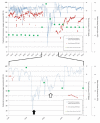Use of therapeutic surfactant lavage in a preterm infant with massive pulmonary hemorrhage
- PMID: 24765473
- PMCID: PMC3981312
- DOI: 10.4081/cp.2012.e74
Use of therapeutic surfactant lavage in a preterm infant with massive pulmonary hemorrhage
Abstract
We report a case of a premature infant presenting with recurrent pulmonary hemorrhage in which we performed a therapeutic lavage with diluted surfactant after an acute episode of bleeding with severe intractable hypoxemia. Repeated small aliquots of diluted surfactant (10×2 mL) allowed rapid improvement in oxygenation and reduction of required mean airway pressures during high frequency oscillatory ventilation. This observation may suggest that surfactant lavage could be beneficial in massive pulmonary hemorrhage in infants. A randomized controlled trial might be needed to clarify the potential benefit of this therapeutic intervention on outcome of infants suffering from this life-threatening complication.
Keywords: prematurity.; pulmonary hemorrhage; surfactant lavage.
Conflict of interest statement
Conflict of interests: the authors declare no potential conflict of interests.
Figures


Similar articles
-
Less invasive surfactant administration versus endotracheal surfactant instillation followed by limited peak pressure ventilation in preterm infants with respiratory distress syndrome in China: study protocol for a randomized controlled trial.Trials. 2020 Jun 11;21(1):516. doi: 10.1186/s13063-020-04390-3. Trials. 2020. PMID: 32527290 Free PMC article.
-
Pulmonary Hemorrhage (PH) in Extremely Low Birth Weight (ELBW) Infants: Successful Treatment with Surfactant.J Clin Diagn Res. 2015 Mar;9(3):SD03-4. doi: 10.7860/JCDR/2015/8596.5691. Epub 2015 Mar 1. J Clin Diagn Res. 2015. PMID: 25954676 Free PMC article.
-
Short-term outcome of pulmonary hemorrhage in very-low-birth-weight preterm infants.Pediatr Neonatol. 2013 Oct;54(5):330-4. doi: 10.1016/j.pedneo.2013.04.005. Epub 2013 May 24. Pediatr Neonatol. 2013. PMID: 23711674
-
Innovation in surfactant therapy I: surfactant lavage and surfactant administration by fluid bolus using minimally invasive techniques.Neonatology. 2012;101(4):326-36. doi: 10.1159/000337346. Epub 2012 Jun 1. Neonatology. 2012. PMID: 22940622 Review.
-
Elective high-frequency oscillatory ventilation versus conventional ventilation for acute pulmonary dysfunction in preterm infants.Neonatology. 2013;103(1):7-8; discussion 8-9. doi: 10.1159/000338553. Epub 2012 Aug 30. Neonatology. 2013. PMID: 23037971 Review.
Cited by
-
[Clinical effect of high-frequency oscillatory ventilation combined with pulmonary surfactant in treatment of neonatal severe meconium aspiration syndrome complicated by pulmonary hemorrhage].Zhongguo Dang Dai Er Ke Za Zhi. 2016 Nov;18(11):1075-1079. doi: 10.7499/j.issn.1008-8830.2016.11.004. Zhongguo Dang Dai Er Ke Za Zhi. 2016. PMID: 27817768 Free PMC article. Chinese.
-
Less invasive surfactant administration versus endotracheal surfactant instillation followed by limited peak pressure ventilation in preterm infants with respiratory distress syndrome in China: study protocol for a randomized controlled trial.Trials. 2020 Jun 11;21(1):516. doi: 10.1186/s13063-020-04390-3. Trials. 2020. PMID: 32527290 Free PMC article.
References
-
- Berger TM, Allred EN, Van Marter LJ. Antecedents of clinically significant pulmonary hemorrhage among newborn infants. J Perinatol. 2000;20:295–300. - PubMed
-
- Finer NN. Surfactant use for neonatal lung injury: beyond respiratory distress syndrome. Paediatr Respir Rev. 2004;5(Suppl A):S289–97. - PubMed
-
- Sweet DG, Halliday HL. The use of surfactants in 2009. Arch Dis Child Educ Pract Ed. 2009;94:78–83. - PubMed
-
- Dargaville PA, Mills JF. Surfactant therapy for meconium aspiration syndrome: current status. Drugs. 2005;65:2569–91. - PubMed
Publication types
LinkOut - more resources
Full Text Sources

